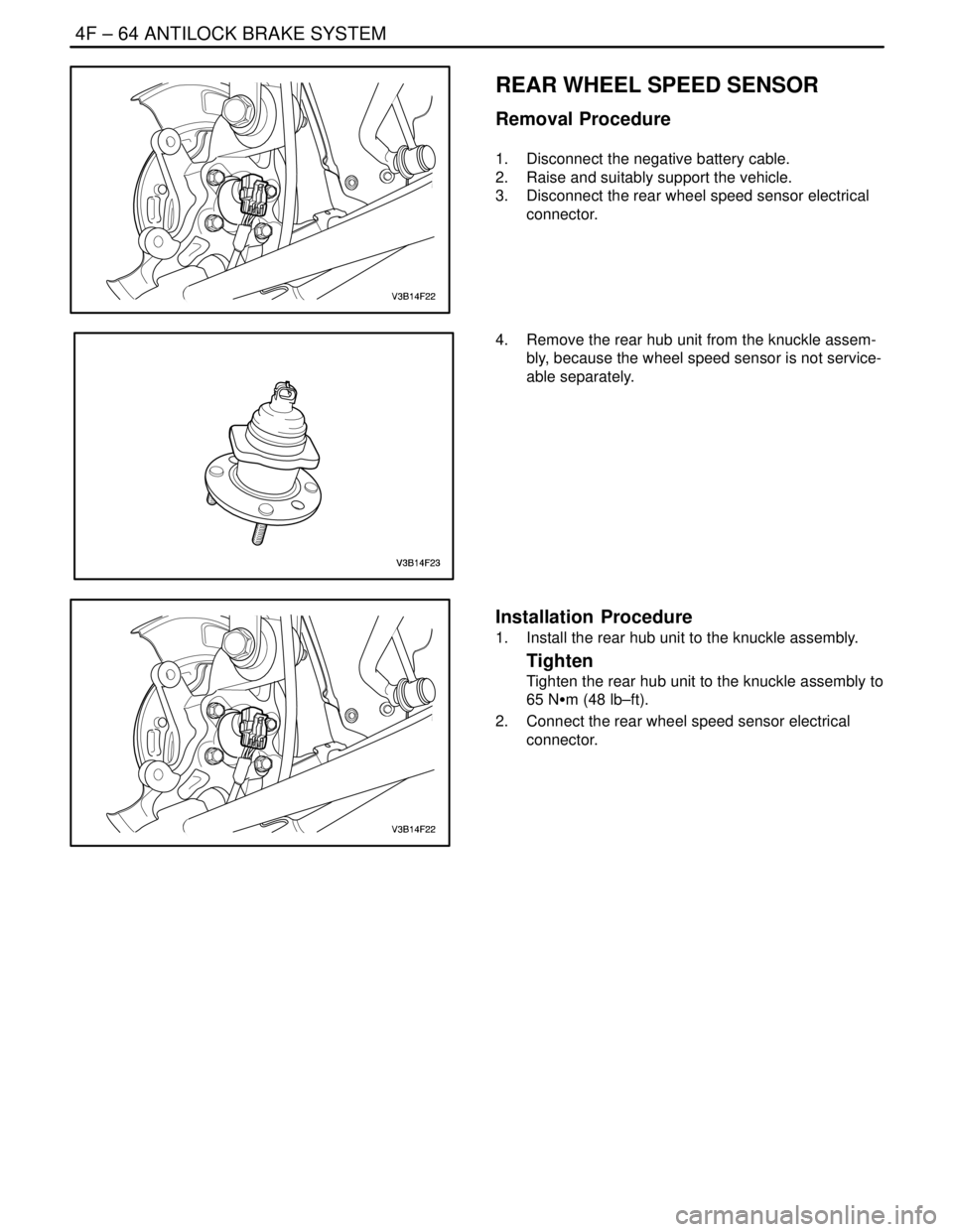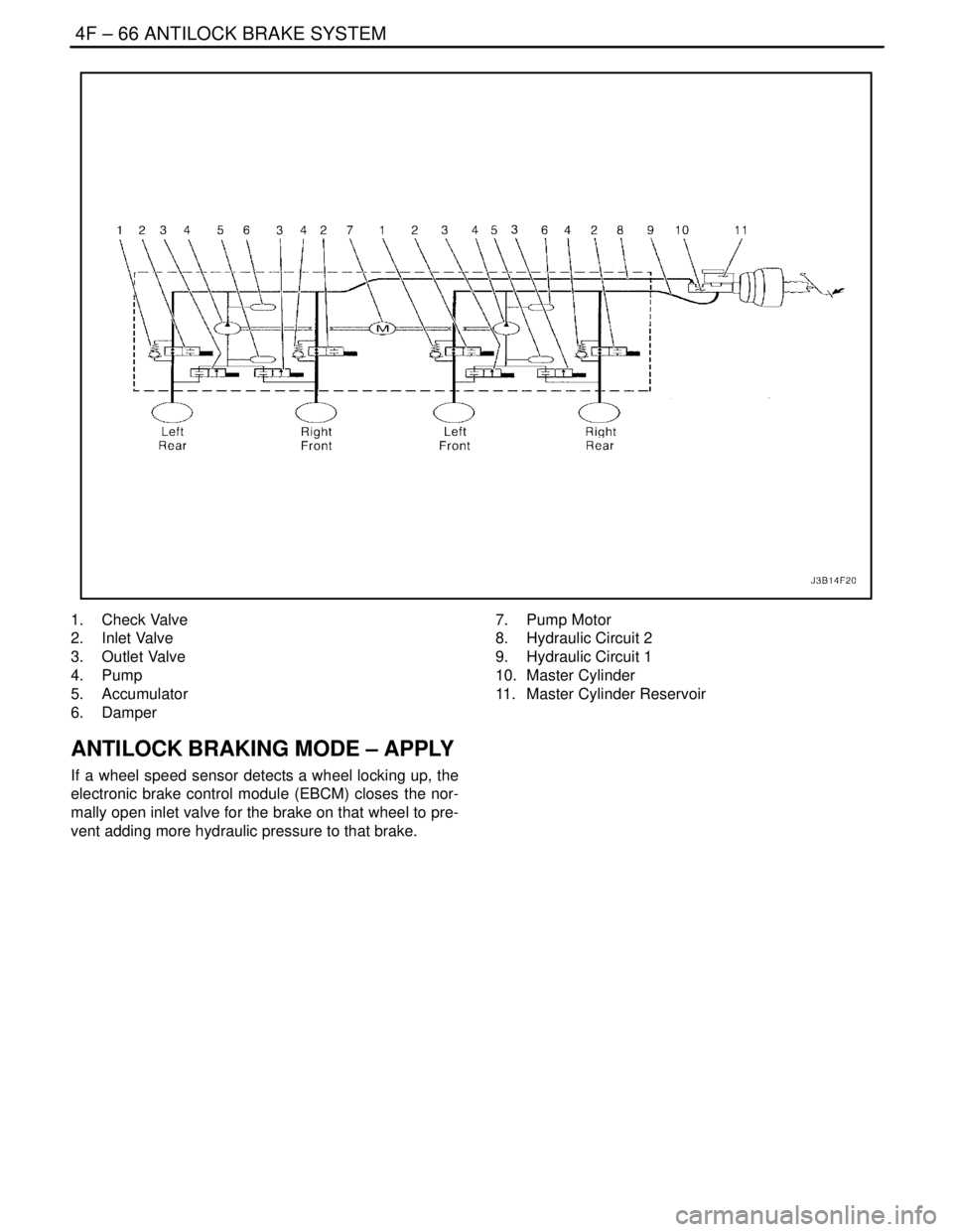2004 DAEWOO LACETTI sensor
[x] Cancel search: sensorPage 1145 of 2643

4F – 64IANTILOCK BRAKE SYSTEM
DAEWOO V–121 BL4
REAR WHEEL SPEED SENSOR
Removal Procedure
1. Disconnect the negative battery cable.
2. Raise and suitably support the vehicle.
3. Disconnect the rear wheel speed sensor electrical
connector.
4. Remove the rear hub unit from the knuckle assem-
bly, because the wheel speed sensor is not service-
able separately.
Installation Procedure
1. Install the rear hub unit to the knuckle assembly.
Tighten
Tighten the rear hub unit to the knuckle assembly to
65 NSm (48 lb–ft).
2. Connect the rear wheel speed sensor electrical
connector.
Page 1146 of 2643

ANTILOCK BRAKE SYSTEM 4F – 65
DAEWOO V–121 BL4
GENERAL DESCRIPTION AND SYSTEM
OPERATION
BASIC KNOWLEDGE REQUIRED
Before using this section, it is important that you have a ba-
sic knowledge of the following items. Without this knowl-
edge, it will be difficult to use the diagnostic procedures
contained in this section.
S Basic Electrical Circuits : You should understand
the basic theory of electricity and know the mean-
ing of voltage, current (amps), and resistance
(ohms). You should understand what happens in a
circuit with an open or shorted wire. You should be
able to read and understand a wiring diagram.
S Use of Circuit Testing Tools : You should know how
to use a test light and how to bypass components
to test circuits using fused jumper wires. You should
be familiar with a digital multimeter. You should be
able to measure voltage, resistance, and current,
and be familiar with the controls and how to use
them correctly.
ABS SYSTEM COMPONENTS
The ABS 5.3 Antilock Braking System (ABS) consists of
a conventional hydraulic brake system plus antilock com-
ponents. The conventional brake system includes a vacu-
um booster, master cylinder, front disc brakes, rear lead-
ing/trailing drum brakes, interconnecting hydraulic brake
pipes and hoses, brake fluid level sensor and the BRAKE
indicator.
The ABS components include a hydraulic unit, an elec-
tronic brake control module (EBCM), two system fuses,
four wheel speed sensors (one at each wheel), intercon-
necting wiring, the ABS indicator, the EBD indicator (which
is connected to the parking lamp) and the rear disk brakes.
See “ABS Component Locator” in this section for the gen-
eral layout of this system.
The hydraulic unit with the attached EBCM is located be-
tween the surge tank and the fire wall on the left side of the
vehicle.
The basic hydraulic unit configuration consists of hydraulic
check valves, two solenoid valves for each wheel, a hy-
draulic pump, two accumulators, and two damper. The hy-
draulic unit controls hydraulic pressure to the front calipers
and rear wheel cylinders by modulating hydraulic pressure
to prevent wheel lockup.
Nothing in the hydraulic unit or the EBCM is serviceable.
In the event of any failure, the entire ABS unit with at-
tached EBCM must be replaced. For more information, re-
fer to ”Base Braking Mode” and ”Antilock Braking Mode”
in this section.
BASE BRAKING MODE
The baseline braking mode of the ABS 5.3 system used
in this vehicle is a diagonal split system. In this system,
one master cylinder circuit supplies pressure to the right
front and the left rear brakes; the other circuit supplies
pressure to the left front and the right rear brakes. All
valves in the hydraulic modulator are in their normal, non–
energized positions as shown in the drawings found in
”ABS System Components” in this section.
Page 1147 of 2643

4F – 66IANTILOCK BRAKE SYSTEM
DAEWOO V–121 BL4
1. Check Valve
2. Inlet Valve
3. Outlet Valve
4. Pump
5. Accumulator
6. Damper7. Pump Motor
8. Hydraulic Circuit 2
9. Hydraulic Circuit 1
10. Master Cylinder
11. Master Cylinder Reservoir
ANTILOCK BRAKING MODE – APPLY
If a wheel speed sensor detects a wheel locking up, the
electronic brake control module (EBCM) closes the nor-
mally open inlet valve for the brake on that wheel to pre-
vent adding more hydraulic pressure to that brake.
Page 1150 of 2643

ANTILOCK BRAKE SYSTEM 4F – 69
DAEWOO V–121 BL4
EBD (ELECTRONIC BRAKE FORCE
DISTRIBUTION) SYSTEM
As an add–on logic to the ABS base algorithm, EBD works
in a range in which the intervention thresholds for ABS
control are not reached yet.
EBD ensures that the rear wheels are sensitively moni-
tored for slip with respect to the front axle. If slip is de-
tected, the inlet valves for the rear wheels are switched to
pressure hold to prevent a further increase in pressure at
the rear–wheel breaks, thus electronically reproducing a
pressure–reduction function at the rear–wheel brakes.
THE BENEFITS OF EBD
S Elimination of conventional proportioning valve.
S EBD utilizes the existing rear axle wheel speed
sensor to monitor rear wheel slip.
S Based on many variables in algorithm a pressure
hold, increase and/or decrease pulsetrain may be
triggered at the rear wheels insuring vehicle stabil-
ity.
S Vehicle approaches the ideal brake force distribu-
tion. (front to rear)
S Constant brake force distribution during vehicle life-
time.
S EBD function is monitored via ABS safety logic.
(conventional proportioning valves are not monitor-
able)
S ”Keep alive” function.
Page 1152 of 2643

ANTILOCK BRAKE SYSTEM 4F – 71
DAEWOO V–121 BL4
TIRES AND ABS/EBD
Replacement Tires
Tire size is important for proper performance of the ABS
system. Replacement tires should be the same size, load
range, and construction as the original tires. Replace tires
in axle sets and only with tires of the same tire perfor-
mance criteria (TPC) specification number. Use of any
other size or type may seriously affect the ABS operation.
TIRES AND ABS/EBD
Notice : There is no serviceable or removable EEPROM.
The EBCM must be replaced as an assembly.
The EBCM is attached to the hydraulic unit in the engine
compartment. The controlling element of ABS 5.3 is a mi-
croprocessor–based EBCM. Inputs to the system include
the four wheel speed sensors, the stoplamp switch, the
ignition switch, and the unswitched battery voltage. There
is an output to a bi–directional serial data link, located in
pin K of Data Link Connector (DLC) for service diagnostic
tools and assembly plant testing.
The EBCM monitors the speed of each wheel. If any wheel
begins to approach lockup and the brake switch is closed
(brake pedal depressed), the EBCM controls the sole-
noids to reduce brake pressure to the wheel approaching
lockup. Once the wheel regains traction, brake pressure
is increased until the wheel again begins to approach lock-
up. This cycle repeats until either the vehicle comes to a
stop, the brake pedal is released, or no wheels approach
lockup.
Additionally, the EBCM monitors itself, each input (except
the serial data link), and each output for proper operation.
If it detects any system malfunction, the EBCM will store
a DTC in nonvolatile memory (EEPROM) (DTCs will not
disappear if the battery is disconnected). Refer to ”Self
Diagnostics” in this section for more detailed information.
FRONT WHEEL SPEED SENSOR
The front wheel speed sensors are of a variable reluctance
type. Each sensor is attached to the steering knuckle,
close to a toothed ring. The result, as teeth pass by the
sensor, is an AC voltage with a frequency proportional to
the speed of the wheel. The magnitude of the voltage and
frequency increase with increasing speed. The sensor is
not repairable, nor is the air gap adjustable.
FRONT WHEEL SPEED SENSOR
RINGS
The toothed ring mentioned above is pressed onto the
wheel–side (outer) constant velocity joint. Each ring con-
tains 47 equally spaced teeth. Exercise care during ser-
vice procedures to avoid prying or contacting this ring. Ex-cessive contact may cause damage to one or more teeth.
If the ring is damaged, the wheel–side constant velocity
joint must be replaced.
REAR WHEEL SPEED SENSOR AND
RINGS
The rear wheel speed sensors operate in the same man-
ner as the front wheel speed sensors. They incorporate a
length of flexible harness with the connector attached to
the end of the harness. The rear wheel speed rings are in-
corporated into the hub assemblies and cannot be re-
placed separately, but require replacement of the rear
hub/bearing assembly.
VALUE RELAY AND PUMP MOTOR
RELAY
The valve relay and the motor pump relay are located in-
side the electronic brake control module (EBCM) and are
not replaceable. If one should fail, replace the EBCM.
WIRING HARNESS
The wiring harness is the mechanism by which the elec-
tronic brake control module (EBCM) is electrically con-
nected to power and to ground, to the wheel speed sen-
sors, the fuses, the switches, the indicators, and the serial
communications port. The components, considered part
of the wiring harness, are the wires that provide electrical
interconnection, and connectors (terminals, pins, con-
tacts, or lugs) that provide an electrical/mechanical inter-
face from the wire to a system component.
INDICATORS
The electronic brake control module (EBCM) continuously
monitors itself and the other ABS components. If the
EBCM detects a problem with the system, the amber ABS
indicator will light continuously to alert the driver to the
problem. An illuminated ABS indicator indicates that the
ABS system has detected a problem that affects the op-
eration of ABS. No antilock braking will be available. Nor-
mal, non–antilock brake performance will remain. In order
to regain ABS braking ability, the ABS must be serviced.
The red BRAKE indicator will be illuminated when the sys-
tem detects a low brake fluid level in the master cylinder
or when the parking brake switch is closed (the parking
brake is engaged) or EBD system is diabled.
WARNING : EBD INDICATOR LAMP WIRING IS CON-
NECTED TO THE PARKING BRAKE LAMP. IF THE
PARKING BRAKE LAMP IS TURNED ON WHEN YOU
DRIVING, CHECKING ON WHETHER THE PARKING
BRAKE LEVER IS ENAGED OR THE BRAKE FLUID
LEVEL IS LOW. IF THE SYSTEM HAS NO PROBLEM,
THE EBD SYSTEM IS WORKING IMPROPERLY. THE
EBD SYSTEM MUST BE SERVICED.
Page 1162 of 2643

SECTION 5
ELECTRICAL WIRING DIAGRAMS
CONTENTS
1. STARTING & CHARGING SYSTEM5–8 . . . . . . . . . . . . . . . . . . . . . . . . . . . . . . . . . . . . . . . . . . . . . . . . . . . . . . . . . . . . . . . .
1) BATTERY, IGNITION SWITCH, STARTER MOTOR, GENERATOR & PNP SWITCH CIRCUIT 5–8. . . . . . . . . .
2. ECM (ENGINE CONTROL MODULE) : MR–140 5–10. . . . . . . . . . . . . . . . . . . . . . . . . . . . . . . . . . . . . . . . . . . . . . . . . . . .
1) BATTERY POWER SUPPLY, GROUND, EI SYSTEM & CKP SENSOR CIRCUIT 5–10. . . . . . . . . . . . . . . . . . . . .
2) FUEL PUMP, INJECTOR & HEATED O2 SENSOR CIRCUIT 5–12. . . . . . . . . . . . . . . . . . . . . . . . . . . . . . . . . . . . . .
3) IAC, SENSOR(MAP, ECT, TP, KNOCK, ACP & ROUGH ROAD) & LEGR CIRCUIT 5–14. . . . . . . . . . . . . . . . . . .
4) EVAP CANISTER PURGE SOLENOID, CMP SENSOR, CLUSTER & VSS CIRCUIT 5–16. . . . . . . . . . . . . . . . .
5) CLUSTER, FUEL PUMP & TCM CIRCUIT 5–18. . . . . . . . . . . . . . . . . . . . . . . . . . . . . . . . . . . . . . . . . . . . . . . . . . . . . .
6) DLC, MIL LAMP & IMMOBILIZER CONTROL CIRCUIT 5–20. . . . . . . . . . . . . . . . . . . . . . . . . . . . . . . . . . . . . . . . . . .
3. ECM (ENGINE CONTROL MODULE) : HV–240 5–22. . . . . . . . . . . . . . . . . . . . . . . . . . . . . . . . . . . . . . . . . . . . . . . . . . . .
1) BATTERY POWER SUPPLY, GROUND, EI SYSTEM & CKP SENSOR CIRCUIT 5–22. . . . . . . . . . . . . . . . . . . . .
2) FUEL PUMP, INJECTOR & O2 SENSOR CIRCUIT 5–24. . . . . . . . . . . . . . . . . . . . . . . . . . . . . . . . . . . . . . . . . . . . . . .
3) IAC, SENSOR(MAP, ECT, TP, IAT, KNOCK & ACP) & EGR VALVE CIRCUIT 5–26. . . . . . . . . . . . . . . . . . . . . . . .
4) EVAP CANISTER PURGE SOLENOID, CMP SENSOR, CLUSTER & VSS CIRCUIT 5–28. . . . . . . . . . . . . . . . .
5) CLUSTER, FUEL PUMP & TCM CIRCUIT 5–30. . . . . . . . . . . . . . . . . . . . . . . . . . . . . . . . . . . . . . . . . . . . . . . . . . . . . .
6) DLC, MIL LAMP, IMMOBILIZER CONTROL & RON SWITCH CIRCUIT 5–32. . . . . . . . . . . . . . . . . . . . . . . . . . . . .
Page 1163 of 2643

ELECTRICAL WIRING DIAGRAMSW5–3
4. ECM (ENGINE CONTROL MODULE) : SIRIUS D4 5–34. . . . . . . . . . . . . . . . . . . . . . . . . . . . . . . . . . . . . . . . . . . . . . . . . .
1) BATTERY POWER SUPPLY, GROUND, EI SYSTEM & CKP SENSOR CIRCUIT 5–34. . . . . . . . . . . . . . . . . . . . .
2) FUEL PUMP, INJECTOR, FUEL CONNECTOR & CMP SENSOR CIRCUIT 5–36. . . . . . . . . . . . . . . . . . . . . . . . .
3) MTIA, SENSOR(ECT, KNOCK, IAT, MAP, ACP & HO2S) & POWER STEERING PRESSURE SWITCH
CIRCUIT : EOBD5–38 . . . . . . . . . . . . . . . . . . . . . . . . . . . . . . . . . . . . . . . . . . . . . . . . . . . . . . . . . . . . . . . . . . . . . . . . . . . . . . . .
4) MTIA, SENSOR(ECT, KNOCK, IAT, MAP, ACP & O2) & POWER STEERING PRESSURE SWITCH
CIRCUIT : NON EOBD5–40 . . . . . . . . . . . . . . . . . . . . . . . . . . . . . . . . . . . . . . . . . . . . . . . . . . . . . . . . . . . . . . . . . . . . . . . . . . .
5) EEGR VALVE, VR SENSOR, CLUSTER & FUEL PUMP CIRCUIT : EOBD 5–42. . . . . . . . . . . . . . . . . . . . . . . . . .
6) EGR VALVE, CLUSTER & FUEL PUMP CIRCUIT: NON EOBD 5–44. . . . . . . . . . . . . . . . . . . . . . . . . . . . . . . . . . . .
7) EVAP CANISTER PURGE SOLENOID, VGIS, CLUSTER, VSS, TCM & RON SWITCH CIRCUIT 5–46. . . . . . .
8) DLC, MIL LAMP & IMMOBILIZER CONTROL CIRCUIT 5–48. . . . . . . . . . . . . . . . . . . . . . . . . . . . . . . . . . . . . . . . . . .
5. TCM (TRANSMISSION CONTROL MODULE) : MR–140/HV–240 5–50. . . . . . . . . . . . . . . . . . . . . . . . . . . . . . . . . . . . .
1) POWER SUPPLY, GROUND, PNP SWITCH, BRAKE SWITCH & SOLENOID VALVE CIRCUIT 5–50. . . . . . . .
2) SENSOR(INPUT SPEED,OUTPUT SPEED, TRANSMISSION FLUID TEMP.), CLUSTER, DLC, ECM &
HOLD MODE SWITCH CIRCUIT5–52 . . . . . . . . . . . . . . . . . . . . . . . . . . . . . . . . . . . . . . . . . . . . . . . . . . . . . . . . . . . . . . . . . .
3) PNP SWITCH & CLUSTER CIRCUIT 5–54. . . . . . . . . . . . . . . . . . . . . . . . . . . . . . . . . . . . . . . . . . . . . . . . . . . . . . . . . . .
6. TCM (TRANSMISSION CONTROL MODULE) : SIRIUS D4 5–56. . . . . . . . . . . . . . . . . . . . . . . . . . . . . . . . . . . . . . . . . .
1) POWER SUPPLY, GROUND, PNP SWITCH, CLUSTER & ECM CIRCUIT : NOTCH BACK 5–56. . . . . . . . . . . .
2) POWER SUPPLY, GROUND, PNP SWITCH, CLUSTER & ECM CIRCUIT : HATCH BACK 5–58. . . . . . . . . . . .
3) BRAKE SWITCH, BTSI SOLENOID, ISS SENSOR & TRANSAXLE CIRCUIT 5–60. . . . . . . . . . . . . . . . . . . . . . . .
4) HOLD MODE SWITCH, VSS & DLC CIRCUIT 5–62. . . . . . . . . . . . . . . . . . . . . . . . . . . . . . . . . . . . . . . . . . . . . . . . . . .
7. AIR CONDITIONER5–64 . . . . . . . . . . . . . . . . . . . . . . . . . . . . . . . . . . . . . . . . . . . . . . . . . . . . . . . . . . . . . . . . . . . . . . . . . . . . .
1) AIR CONDITIONER CONTROL SWITCH, BLOWER MOTOR RESISTER & BLOWER MOTOR
CIRCUIT5–64 . . . . . . . . . . . . . . . . . . . . . . . . . . . . . . . . . . . . . . . . . . . . . . . . . . . . . . . . . . . . . . . . . . . . . . . . . . . . . . . . . . . . . . . .
2) AIR CONDITIONER CONTROL, INTAKE MOTOR SWITCH & AIR CONDITIONER COMPRESSOR
CIRCUIT5–66 . . . . . . . . . . . . . . . . . . . . . . . . . . . . . . . . . . . . . . . . . . . . . . . . . . . . . . . . . . . . . . . . . . . . . . . . . . . . . . . . . . . . . . . .
Page 1164 of 2643

5–4WELECTRICAL WIRING DIAGRAMS
8. FATC (FULL AUTOMATIC TEMPERATURE CONTROL) 5–68. . . . . . . . . . . . . . . . . . . . . . . . . . . . . . . . . . . . . . . . . . . .
1) BLOWER MOTOR, INTAKE MOTOR, MODE MOTOR, MAX HIGH RELAY & POWER TR CIRCUIT 5–68. . . .
2) SENSOR(AMBIENT,INCAR,SUN&WATER), AIR MIX DOOR MOTOR, A/C COMPRESSOR & ECM
CIRCUIT5–70 . . . . . . . . . . . . . . . . . . . . . . . . . . . . . . . . . . . . . . . . . . . . . . . . . . . . . . . . . . . . . . . . . . . . . . . . . . . . . . . . . . . . . . . .
2–1) MR–140/HV–2405–70 . . . . . . . . . . . . . . . . . . . . . . . . . . . . . . . . . . . . . . . . . . . . . . . . . . . . . . . . . . . . . . . . . . . . . . . .
2–2) SIRIUS D45–72 . . . . . . . . . . . . . . . . . . . . . . . . . . . . . . . . . . . . . . . . . . . . . . . . . . . . . . . . . . . . . . . . . . . . . . . . . . . . .
9. RADIATOR COOLING FAN CIRCUIT 5–74. . . . . . . . . . . . . . . . . . . . . . . . . . . . . . . . . . . . . . . . . . . . . . . . . . . . . . . . . . . . . .
1) COOLING FAN CIRCUIT(MR–140/HV–240) : DUAL 5–74. . . . . . . . . . . . . . . . . . . . . . . . . . . . . . . . . . . . . . . . . . . . . .
2) COOLING FAN CIRCUIT(MR–140/HV–240) : SINGLE 5–76. . . . . . . . . . . . . . . . . . . . . . . . . . . . . . . . . . . . . . . . . . . .
3) COOLING FAN CIRCUIT(SIRIUS D4) : DUAL 5–78. . . . . . . . . . . . . . . . . . . . . . . . . . . . . . . . . . . . . . . . . . . . . . . . . . .
4) COOLING FAN CIRCUIT(SIRIUS D4) : SINGLE 5–80. . . . . . . . . . . . . . . . . . . . . . . . . . . . . . . . . . . . . . . . . . . . . . . . .
10. HEAD LAMP & HEAD LAMP LEVELING DEVICE(HLLD) CIRCUIT 5–82. . . . . . . . . . . . . . . . . . . . . . . . . . . . . . . . . . .
1) NOTCH BACK5–82 . . . . . . . . . . . . . . . . . . . . . . . . . . . . . . . . . . . . . . . . . . . . . . . . . . . . . . . . . . . . . . . . . . . . . . . . . . . . . . .
2) HATCH BACK5–84 . . . . . . . . . . . . . . . . . . . . . . . . . . . . . . . . . . . . . . . . . . . . . . . . . . . . . . . . . . . . . . . . . . . . . . . . . . . . . . .
11. ILLUMINATION CIRCUIT5–86 . . . . . . . . . . . . . . . . . . . . . . . . . . . . . . . . . . . . . . . . . . . . . . . . . . . . . . . . . . . . . . . . . . . . . . . .
1) ILLUMINATION CIRCUIT– W/O DIMMER CONTROL 5–86. . . . . . . . . . . . . . . . . . . . . . . . . . . . . . . . . . . . . . . . . . . .
2) ILLUMINATION CIRCUIT– W/ DIMMER CONTROL 5–88. . . . . . . . . . . . . . . . . . . . . . . . . . . . . . . . . . . . . . . . . . . . . .
3) LAMP(LICENSE PLATE & W/ FRONT/REAR POSITION) CIRCUIT : NOTCH BACK 5–90. . . . . . . . . . . . . . . . . .
4) LAMP(LICENSE PLATE & W/ FRONT/REAR POSITION) CIRCUIT : HATCH BACK 5–92. . . . . . . . . . . . . . . . . .
12. FRONT & REAR FOG LAMP CIRCUIT 5–94. . . . . . . . . . . . . . . . . . . . . . . . . . . . . . . . . . . . . . . . . . . . . . . . . . . . . . . . . . . .
1) NOTCH BACK5–94 . . . . . . . . . . . . . . . . . . . . . . . . . . . . . . . . . . . . . . . . . . . . . . . . . . . . . . . . . . . . . . . . . . . . . . . . . . . . . . .
2) HATCH BACK5–96 . . . . . . . . . . . . . . . . . . . . . . . . . . . . . . . . . . . . . . . . . . . . . . . . . . . . . . . . . . . . . . . . . . . . . . . . . . . . . . .
13. HAZARD & TURN SIGNAL LAMP CIRCUIT 5–98. . . . . . . . . . . . . . . . . . . . . . . . . . . . . . . . . . . . . . . . . . . . . . . . . . . . . . .
1) NOTCH BACK5–98 . . . . . . . . . . . . . . . . . . . . . . . . . . . . . . . . . . . . . . . . . . . . . . . . . . . . . . . . . . . . . . . . . . . . . . . . . . . . . . .
2) HATCH BACK5–100 . . . . . . . . . . . . . . . . . . . . . . . . . . . . . . . . . . . . . . . . . . . . . . . . . . . . . . . . . . . . . . . . . . . . . . . . . . . . . .